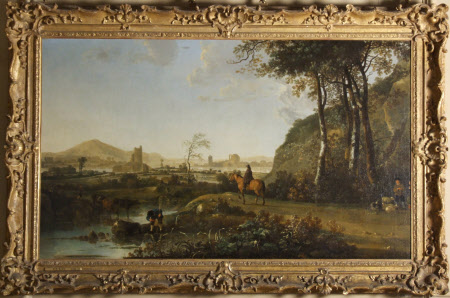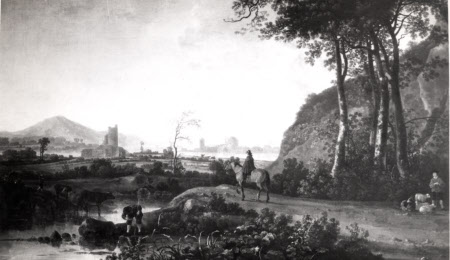Rider and Herdsman in an Imaginary Landscape with a Ruined Castle and Distant Town
Aelbert Cuyp (Dordrecht 1620 - Dordrecht 1691)
Category
Art / Oil paintings
Date
circa 1650 - 1659
Materials
Oil on canvas
Measurements
1130 x 1765 mm (44 1/2 x 69 1/2 in)
Place of origin
Nijmegen
Order this imageCollection
Petworth House and Park, West Sussex
NT 486177
Summary
Oil painting on canvas, Rider and Herdsman in an Imaginary Landscape with a Ruined Castle and Distant Town by Aelbert Cuyp (Dordrecht 1620 – Dordrecht 1691), 1650s. A view of the mountainous country around Nijmegen. On the right, a high hill, in front of which is a cluster of tall trees and a peasant boy with three sheep and a goat. A farmer, wearing a cloak, and riding a bright bay horse, is on some rising ground in the centre. In the right foreground, a herdsman in a blue jacket stands on the bank, taking up water in a cup. Beyond him a peasant drives three cows into the stream. The distant country is divided by hedges and traversed by a river, with a castle on its bank, and a tower at the confluence of the river.
Provenance
Possibly Thomas Moore Slade, c.1795, when 'the famous long landscape of Cuyp' was amongst the pictures from his collection that he sold to 'my good friend, Sir Philip Stephens'; Sale of Sir Philip Stephens (1723 – 1809) sale, Christie's, 17 May 1810, lot 99 (Cows watering; horsemen): in Christie's marked cat. as sold to Bonelli for 1600 gns. (whereas the pendant, lot 100, has 1000 gns., but no name, against it, so bought in), but according to Smith, bought in, so presumably the owner would not sell one picture without the other; by inheritance to Thomas Jones, 6th Viscount Ranelagh (1763–1820) (lent to British Institution exhibition in 1819); Viscount Ranelagh sale, Christie's, 23 June 1821, lot 95: originally sold at 990 gns., but ultimately bought in, because its supposed pendant was bought in at 190 gns.; bought by W. Peacock at Lord Ranelagh's posthumous sale, Christie's, 16 May 1829, lot 24, for 1,010 gns. (described as 'CAPITAL'), whereas its supposed pendant remained unsold); in Petworth collection by 1834 thence by descent, until the death in 1952 of the 3rd Lord Leconfield, who had given Petworth to the National Trust in 1947, and whose nephew and heir, John Wyndham, 6th Lord Leconfield and 1st Lord Egremont (1920-72) arranged for the acceptance of the major portion of the collections at Petworth in lieu of death duties (the first ever such arrangement) in 1956 by HM Treasury
Credit line
Petworth House, The Egremont Collection (acquired in lieu of tax by HM Treasury in 1956 and subsequently transferred to the National Trust)
Makers and roles
Aelbert Cuyp (Dordrecht 1620 - Dordrecht 1691), artist
References
Buchanan 1824 W. Buchanan, Memoirs of Paintings, 2 vols., London, 1824, 1824, vol. I, pp. 320-21 & 326-27; Smith 1829-42 John Smith, A Catalogue Raisonné of the Works of the Most Eminent Dutch, Flemish, and French Painters, 8 vols and supplement, London, 1829-42, vol.V, 1834, p.315, No. 113; Waagen 1857 Gustav Waagen, Galleries and Cabinets of Art in Great Britain, London, 1857, 1857, p. 40; Hofstede de Groot 1907-28: C. Hofstede de Groot, A Catalogue Raisonné of the Most Eminent Dutch Painters of the Seventeenth Century, 8 vols., London 1907-28, Vol.II, Nos. 337, 444 Reiss 1975 Stephen Reiss, Aelbert Cuyp, 1975, No. 145, p. 190


